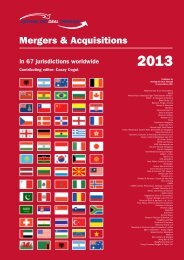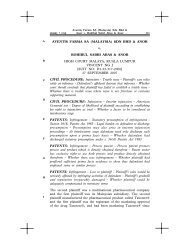Article.4.Mediation Then and Now.April.2007 - Mackrell International
Article.4.Mediation Then and Now.April.2007 - Mackrell International
Article.4.Mediation Then and Now.April.2007 - Mackrell International
You also want an ePaper? Increase the reach of your titles
YUMPU automatically turns print PDFs into web optimized ePapers that Google loves.
MEDIATION THEN AND NOW<br />
PAUL JACOBS, Q.C., C.MED., C.ARB.<br />
Fifteen or twenty years ago, when one looked at the spectrum of processes available in<br />
the nature of alternative dispute resolution, mediation formed only one of several different<br />
alternatives. Most of the alternatives related more to the nature of a quasi-judicial proceeding;<br />
for example, mini trials, pre-trials, arbitration <strong>and</strong> neutral evaluation type proceedings. By their<br />
nature, those proceedings were typically adversarial <strong>and</strong> rights-based.<br />
When I wrote articles or gave lectures on alternative dispute resolution in the late 1980’s<br />
<strong>and</strong> early 1990’s, I had to define mediation <strong>and</strong> explain the process to lawyers who were largely<br />
unfamiliar with it. I explained that unlike those adversarial type proceedings, mediation was<br />
really a form of negotiation assisted by an individual who would bring both facilitation <strong>and</strong><br />
process to the negotiation. The parties would not be sworn, but would be expected to tell the<br />
truth. The framework of the process would be confidential <strong>and</strong> therefore, if unsuccessful, could<br />
not be discussed at a later time in any court proceeding. The magic of the process was that the<br />
parties had an opportunity to speak face to face probably for the first time since their dispute<br />
arose. In a controlled but relaxed environment, with a facilitator who understood the issues <strong>and</strong><br />
was trained in the process, significant settlement rates could be achieved.<br />
Back in those days, mediation was just coming into the legal vocabulary. Many were still<br />
making mockery of it as a form of meditation. Others were criticizing it as a wimp mentality as<br />
opposed to a warrior mentality involved in litigation proceedings. In many parts of the world in<br />
common law jurisdictions <strong>and</strong> in particular, in civil law jurisdictions, mediation was virtually<br />
unknown. The global legal community was familiar with arbitration on both a domestic <strong>and</strong> an<br />
international basis. Arbitration had been created as a creature of statute in the late nineteenth<br />
century. There was significant familiarity with the process <strong>and</strong> parties in legal disputes tended to<br />
underst<strong>and</strong> it. How times have changed!<br />
Even ten or fifteen years ago I had to check with the lawyers privately in advance of a<br />
mediation to find out if they had ever attended one before <strong>and</strong> to learn what they had explained
- 2 -<br />
to their clients about the process. This was not a step I took lightly because I did not want to<br />
insult, but at the same time it was more than apparent that many lawyers had never been to a<br />
mediation <strong>and</strong> really did not underst<strong>and</strong> how it worked. Many were wary of embarking on a<br />
process that they were unfamiliar with. In those days, when I lectured on the topic, I told<br />
lawyers they could compare the process in some ways with sex. Before anyone tried it, they had<br />
heard lots about it, knew that they wanted to try it, but were a little intimidated <strong>and</strong> embarrassed<br />
before their first time. On the other h<strong>and</strong>, once they had experienced it, they were converts <strong>and</strong><br />
wanted more of it. Today that might be a politically incorrect way of describing the situation,<br />
but it certainly opened eyes <strong>and</strong> made people listen in those days.<br />
Mediation is now widely used in North America. There are jurisdictions in which<br />
mediation is prescribed by statute, by rule of practice, by judicial direction, or by judicial order.<br />
Of course, there is voluntary mediation in any type of situation when the parties choose to access<br />
the process.<br />
There are both m<strong>and</strong>atory <strong>and</strong> voluntary forms of mediation in litigation matters. The<br />
experience in my jurisdiction of Ontario, Canada is that m<strong>and</strong>atory mediations achieve a level of<br />
approximately 45% success <strong>and</strong> voluntary mediations achieve settlement rates with over 80%<br />
success. I believe these results are fairly widespread based on anecdotal information from<br />
mediators in many jurisdictions.<br />
Moreover, mediation has become an accepted process available to deal with almost any<br />
type of dispute. It has particular attraction in cases where parties have a dispute, but really need<br />
to continue doing business together. For example, this would be the case in construction<br />
projects, supply agreements, corporate workplaces, shareholder <strong>and</strong> partnership disputes <strong>and</strong> so<br />
on. But even in one-off relationships such as personal injury, sexual harassment, or even estate<br />
matters, mediation has proven itself to be the process of choice.
- 3 -<br />
Why has mediation achieved such levels of success in such a relatively short time? There<br />
are certain aspects to this process that make it highly attractive. Firstly, it is very quick.<br />
Secondly, the parties agree on a mediator <strong>and</strong> fix a date. Thirdly the matter proceeds on that date<br />
on a fairly simplified brief. Mediators do not double book or have long lists as is so common in<br />
court matters. As a result of the timing expediency, costs are cut drastically by comparison with<br />
other legal proceedings. For example, even by comparison with arbitration, there is firstly, no<br />
arbitrator to pay. Secondly, there is no lengthy hearing <strong>and</strong> calling of evidence, witnesses <strong>and</strong><br />
other such formalities. Thirdly, mediations can be conducted without lawyers by the parties with<br />
the mediator alone, or with counsel or other assistance. For the most part in my experience,<br />
mediations involve the principals in the dispute along with their lawyers. Fourthly, while there<br />
are both rights-based <strong>and</strong> interest-based mediations, one of the really novel aspects of mediation<br />
is to look at the interests of the parties rather than their legal rights. By cutting through the legal<br />
rights formalities <strong>and</strong> the remedies mentality, the parties are focused on their interests <strong>and</strong> what<br />
really matters is finding a resolution. Fifthly, the parties are the authors of their settlement <strong>and</strong><br />
as a result, enforcement is virtually never a problem. Compare this with the difficulties which<br />
often arise after arbitral awards are made <strong>and</strong> have to be enforced in a court. This is a<br />
particularly serious problem in international arbitration <strong>and</strong> much law has developed at the<br />
judicial level internationally just dealing with issues of enforcement of arbitral awards. Where<br />
the parties have a direct h<strong>and</strong> in reaching the agreement <strong>and</strong> not having it imposed upon them,<br />
they are keen to perform its terms as quickly as possible in order to implement the settlement.<br />
For all of these reasons <strong>and</strong> many others, the acceptability level of mediation has grown<br />
rapidly in North America. It is used widely in various forms throughout Canada <strong>and</strong> the United<br />
States <strong>and</strong> has a continuing growth throughout Europe, South America <strong>and</strong> other parts of the<br />
world.
- 4 -<br />
Indeed now when we look at alternative forms of dispute resolution, we find a<br />
substantially increased list. This list includes terms such as facilitation, conciliation, med-arb,<br />
arb-med, deal mediation, collaborative law <strong>and</strong> circle process.<br />
In my submission, all of these processes are really processes which involve mediation in<br />
one fashion or another. Some argue that facilitation <strong>and</strong> conciliation are really just other terms<br />
for mediation, sometimes in the international setting. The concepts of med-arb <strong>and</strong> arb-med,<br />
have developed substantially over the last ten years <strong>and</strong> when carried out properly, are really<br />
separate processes which have in common the fact that one person may be involved as the<br />
neutral in both processes.<br />
In deal mediation, there is no existing litigation between the parties <strong>and</strong> there may or may<br />
not be counsel involved. Typically, the parties are connected through some commercial<br />
agreement in which there is a dispute, or they may recognize the need to negotiate a new<br />
agreement. A typical case would involve 50-50 shareholders in a company who have reached a<br />
deadlock on an important issue <strong>and</strong> need assistance to overcome the problem while they continue<br />
to operate the company.<br />
In collaborative law, the parties <strong>and</strong> their lawyers sign an agreement that they will<br />
negotiate in good faith <strong>and</strong> not undertake legal proceedings in any case. What really exists here<br />
is a mediation where the two lawyers are essentially the mediators <strong>and</strong> their clients are the<br />
negotiating parties.<br />
Circle process originated with the aboriginal peoples of North America. In this type of<br />
process, typically, an elder was the neutral who led the discussion. Because often more than two<br />
persons were involved, the parties actually sat around in a circle. Many mediations also take<br />
place around a circular table. The reason for this is to establish equality amongst all participants<br />
with no one at the head of the table or in a position of power one over the other. This process
- 5 -<br />
has now found its way into criminal sentencing matters <strong>and</strong> various forms of civil dispute<br />
resolution which may involve estate disputes, corporate workplace disputes, or ratepayer<br />
municipal disputes.<br />
It is my observation, <strong>and</strong> my submission that mediation has been one of the most rapidly<br />
growing processes known in the evolution of legal history <strong>and</strong> more particularly, settlement of<br />
legal disputes. These numerous variations, in my submission, are evidence of successful spinoffs<br />
from the fundamental concept of interest-based mediation.<br />
If it has taken 500 years for our legal rules of law to develop through the judicial systems,<br />
it has probably taken only 500 weeks for the legal community to accept <strong>and</strong> build upon<br />
mediation as an interest-based dispute resolution process.<br />
It is said that the law moves slowly, but it has also been recognized in recent times that<br />
lawyers are a fast read. Indeed, how swiftly we have moved to accept <strong>and</strong> promote mediation,<br />
both domestically <strong>and</strong> internationally.<br />
Paul Jacobs, Q.C., C.Med., C.Arb.<br />
July 2007<br />
1,545 words












